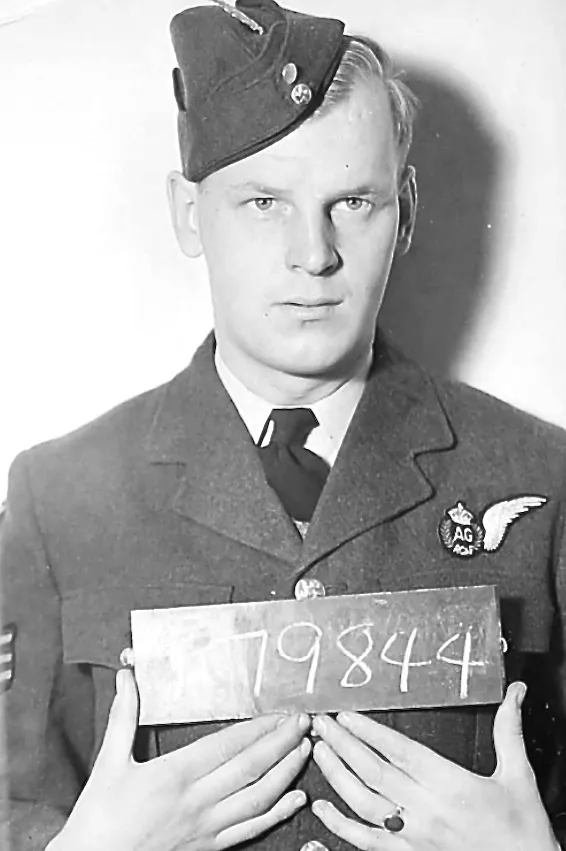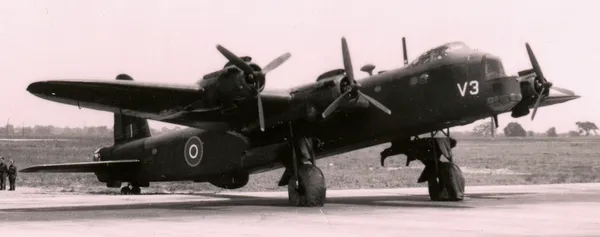214 Federated Malay States Squadron (Ultor In Umbris). Stirling aircraft RF 445 was returning from a raid against Berlin, Germany when it was attacked by a German FW-190 fighter aircraft while over the Zuyder Zee. Although FS Sweeney was wounded in the attack he managed to shoot down the enemy fighter. The pilot of the Stirling, not Canadian, was forced to ditch the aircraft in the North Sea and was killed. FS Sweeney couldn't make it to the dinghy in the cold water and succumbed to his wounds and the cold. Five RAF members of the crew survived and were picked up safely. The following is reprinted from a story that was in a Weyburn Wartime Newspaper. HOW WEYBURN MAN LOST LIFE GRAPHICALLY TOLD. How Sergeant Wilfred Sweeney met his death in the North Sea when returning from a raid over Germany, is graphically told by a member of the Lancaster bomber in which he was the rear gunner. The letter was written by Sergeant D.C. Hughes to his mother, in Bremerton, Washington, and forwarded by her to Mr. and Mrs. F. Sweeney in Weyburn, knowing they would be interested in their son's fate. The letter is as follows: Well mother I think tell you something that I was going to keep from you, but on second thought, you'll find out sooner or later, and I'd rather I told you than someone else. You know how people exaggerate on a subject. On the 22nd of November we were on an operation (censored). The trip went easy until we got to the target. The flack wasn't too bad, but our trouble started (censored) bad weather conditions we couldn't maintain altitude. We came from (censored) down to (censored). The skipper (pilot) George asked us whether we wanted to throw our equipment and guns to lighten the aircraft, thus gain back our altitude or keep everything and go down to zero altitude and fly it out, using our luck. We all agreed to go down and fly it out. Down we went to (censored) and all went well until we got (censored) there the ground defence opened up at us and gave us a terrible raking - it was here that Wilf caught a packet, he was wounded in the right leg with flack - the skipper told him to leave his guns in the rear turret and get first aid for his leg - but he wouldn't, he said he'd stick by his guns. It seemed a lifetime before we got out of the flack and searchlight. All was quiet again, although we all knew we'd never make England, we didn't have enough petrol. We were in hope that we'd make the North Sea and crash land in the sea. It wasn't until we were over the Zuyderzee 'Sea that trouble caught up with us. A fighter attacked us at 400 yards. Wilt opened fire first and the fighter burst in flames and crashed into the sea. About this time we were over Holland and their defenses opened up, boy I thought hell had opened up instead. By this time we were so low that the skipper and the bombaimer had to pull up for fear of hitting houses. The gunners took advantage of this low altitude and fired at searchlights and flack batteries. Between the two gunners they put over twenty-five lights and batteries out of action. The aircraft was torn with holes. But none of us were hit except Wilt, our rear gunner, and he went on firing. We finally got out over the North Sea. Then the skipper told us to take up crash stations and prepare for ditching. Everyone went about his job as though it were only practice. I told the skipper how many minutes petrol we had left and Jock (wirelss opp.) had given base the spot in which we were going to ditch. Once in our crash position we sat and waited, the skipper sang out the altitude over the inter-corn 10 ft-75ft----50 ft hold tight--here. We hit the water once lightly, then the second time I thought the world had come to an end. Godl what a crashl Then a split second after the crash and there was a wall of water down on us. Out of my escape hatch goes the rear gunner, mid-upper gunner, and navigator, then myself. Well everything got a bit mixed. I was last out, but Ronny (mid-upper) went before me and he had to get stuck in the hatch. So there I was standing up to my knees in water, needless to say I was good and worried. But he finally got loose, when I got out there was only Johnny and Jack hanging on the the aircraft. Then I saw Jack slip off in the water. I thought he was a gonner, and Johnny was a bit off his head, he was hunting for the- big dinghy and in the wrong wing. You see the big dinghy had already gone without us, because of heavy seas. So I went back into the aircraft and got the emergency dinghies, one of which I gave to Johnny and I inflated one for myself. Just then a big wave came and washed me into the sea. I was soaked to the skin, but was able to clamber into my little dinghy. I was about ten yards away from the aircraft, when she put her nose down and slid into the briny deep. I spent about an hour and a half by myself, all the time blowing like hell on my little whistle, hoping someone would hear me. Finally the fellows in the big dinghy heard me and paddled toward me. I spent the remainder of the time with them until we were picked up by a R.A.F. rescue launch. We were first sighted by Hudsons who radioed for the launch. In all we spent fourteen hours on the water, wet through and through. The boys on the launch rubbed us down good and hard and put us to bed. They are the ones we thank for not suffering from exposure. They did a grand job. Once ashore we were rushed off to hospital. I was the only survivor to come out of it without any ill effects, though four got bad coughs. Yes, we lost two of the crew, George the skipper, and Wilf the rear gunner. George was killed on impact when we hit the sea or otherwise drowned before he had a chance to get out. Wilf got out alright, but was drowned trying to get to the dinghy. As yet I still can't seem to realize them dead. They had so much to live for, both were engaged to be married. I'm beginning to think only the good die young, so I'm going to be a real devil. When we get out of hospital and back to camp they (the RAF) sent us off on leave. They gave us ten days' leave, then we went back, stayed three days, and again sent us off on ten days, which I am on now. We go back this Monday and are hoping to get a new skipper and gunner and get back to flying, and pay Jerry back in full for Wilf and George. Well, Mom, we are trying to forget about our mishaps. I suppose it's all in a lifetime.


